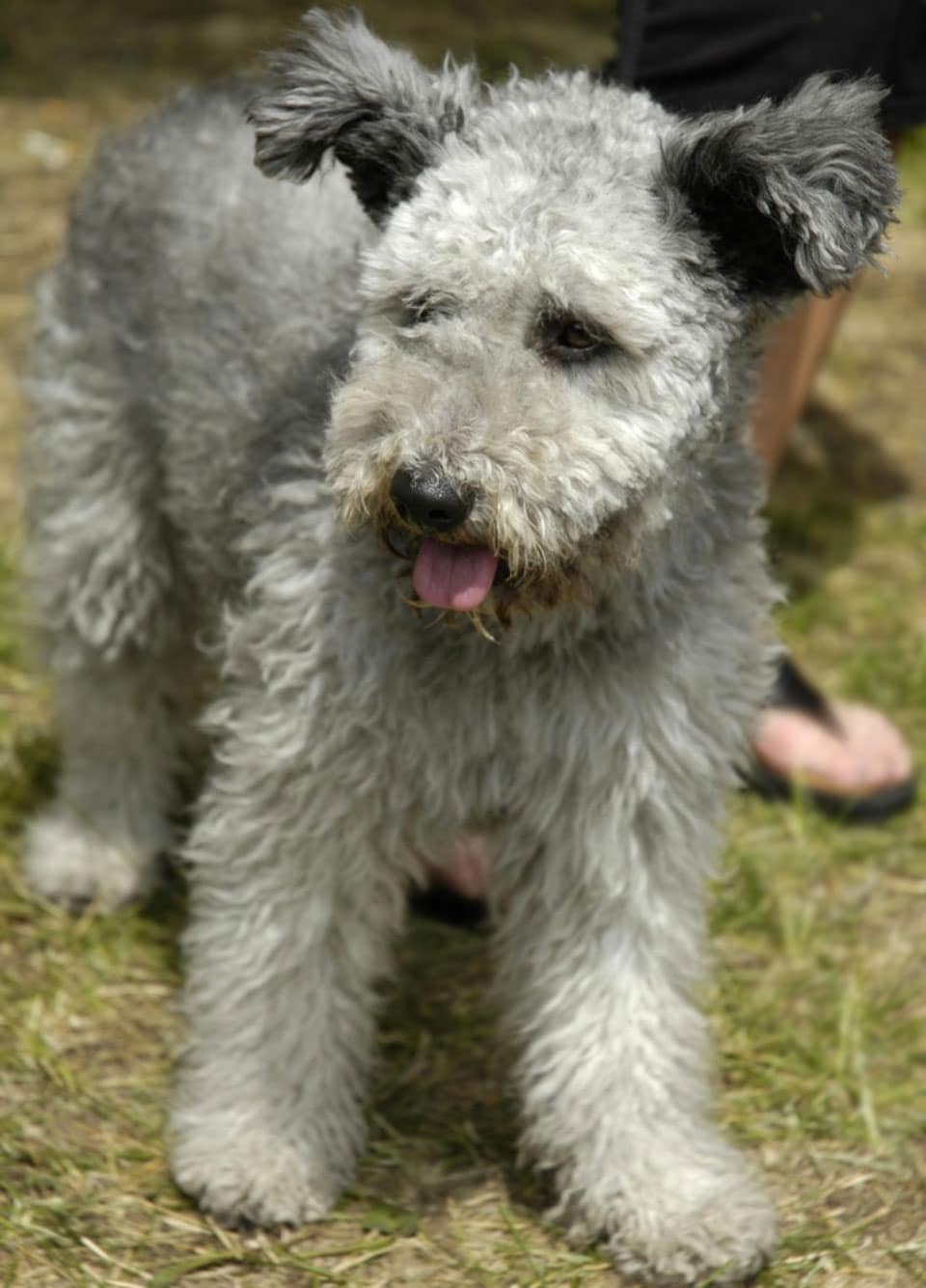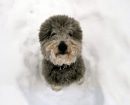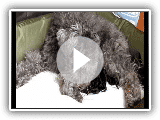Content |
|---|
History
The Pumi It is a herding dog size medium of the Terrier group, originally from Hungary.
The Pumi has been used as a "general farm dog", in grazing sheep not only, but also cows and pigs, and also for catching small rodents. Originated from the 17TH and 18th century, When the grazing done by dogs Terrier, brought to Hungary from Germany and France, it was common. These Terrier-type dogs, they were mixed with native Hungarian sheepdogs, and the result of such crossing gave rise to the sympathetic current Pumi, It is a dog of Terrier blood but with the heart of dog. He was raised as a working dog, an autonomous and free animal.
The breed was developed until the of 1970, and within their ancestors or, in the crosses which gave rise to the Pumi, other Hungarian dogs such as the Puli and Mudi.
The Pumi received recognition Federation Cynologique Internationale in the year 1966. The breed was largely unknown outside of Hungary until the year 1970. In 1973, the first Pumi were exported to Finland, and in 1985 to Sweden. Later, they were also exported to Germany, Netherlands, Italy, and in the Decade of 1990 to United States. In 2004 the Pumi was accepted by the American Kennel Club, the registry was created and the American Club of the Hungarian Pumi was founded. The 1 in January of 2011, The Pumi was accepted into the AKC's "Miscellaneous Class" group. Group which includes several different races.
The Pumi, originally, It was used as a grazing dog, but currently, most of them are used for other purposes such as various dog competitions (Dog Agility, Dog Dancing, Obedience) and for other purposes, like search and rescue or wild boar hunting, for example.
In the news, the Pumi is still, relatively, unknown outside Hungary, but in Sweden and Finland are registered each year about 100 copies of Pumi every year.
in both countries, They are used as companion dogs and in canine Agility competitions., They can be seen almost every year in important Championships of each country.
Physical characteristics
The Pumi is a dog of body light, with a long, thin head. The snout is a 45% the length of his head. The stop is quite pronounced and the skull is flat seen from one side. The eyes are small, dark, very lively and slightly oblique.
The males of the Pumi race measure of 41 to 47 cm. to the cross and weigh in 10 to 15 kg, the females measure of 38 to 44 cm and weigh in 8 to 13 kg.
Most Pumi are gray, any gray-scale is accepted at the dog shows. The grey Pumi are born black but begin to gradually where starting at the 6 u 8 weeks. The final color can predict the color of their parents. They are also accepted colors black, white or “maszkos fakó” (It is a color between yellow and Brown with a darker mask).
The the mantle is double layer, a looped collector external of thick hair of, approximately, 7 cm length, and a soft smooth internal layer. It should combed every few weeks and cut each 2 or 4 months (If necessary). The layer of hair is constantly growing (As of the Poodle) and, If not maintained a regular toilet, the hair can be damaged.
The leading brand of the Pumi are their ears, always warning she takes them upright and with the tip bent down. They are coated in perlo longer than in the rest of the body.
It is a dog that is in good health and has a life expectancy of between 12 and 14 years, Although known cases with 19 years of life to the dying.
Problems known are the hip dysplasia and luxation, but it is not a race at risk for hip dysplasia, at least not contained in the Ranking of dogs affected by hip dysplasia. Best health records are found in Finland and Sweden and the 80% of the Pumi are born with healthy hips.
Character and skills
The Pumi, It is usually a dog very Protector with his family but is suspicious and reserved with strangers, and as with all can, proper socialization will decrease their level of mistrust.
It's a race alive and active, Intelligent and quite latrans. They are - moderately- easy to train on all using toys and food.
Although he is affectionate with his family, always keeps its degree of independence, Perhaps that his character stroke coupled with his ability to exterminate rodents, one of the legacies is clearer that have left you their Terrier ancestors.
Observations
Despite the fact that its overall appearance tell us that the Pumi is a stuffed animal, We can not confuse us, It is a dog, and also with a quite marked character.
Pumi Health
The Pumi is a generally healthy breed with a life expectancy of 13 to 15 years.
All dogs have the potential to develop genetic health problems, just as all people have the potential to inherit a particular disease. Run, do not walk, from any breeder who does not offer a health guarantee for their puppies, to tell you that the breed is 100 percent healthy and has no known problems, or saying that your puppies are isolated from the main part of the home for health reasons. A reputable breeder will be honest and open about the breed's health problems and the incidence with which they occur in their lines..
The Pumi breed is generally healthy, but there is some incidence of hip dysplasia in the breed. Responsible breeders test DNA for degenerative myelopathy and an eye disease called primary lens luxation. Neither disease is common, but they can happen. They also look for a knee problem called a patellar dislocation and sometimes a dysplasia in the elbow..
If a breeder tells you that you do not need to do these tests because they have never had problems in their lines and their dogs have been “reviewed by the veterinarian”, then you must find another breeder who is more rigorous with genetic testing.
Careful breeders test their dogs for genetic diseases and breed only the healthiest and best looking specimens.. But sometimes mother nature has other ideas, and a puppy develops one of these diseases despite good husbandry practices. Advances in veterinary medicine mean that in many cases, dogs can still live a good life. If you are going to have a puppy, ask the breeder about the ages of the dogs in his line and what caused their deaths.
Remember that after you have fostered a new puppy in your home, has the power to protect you from one of the most common canine health problems: the obesity. Keeping a Pumi at the right weight is one of the easiest ways to extend its life..
Pumi toilet
Pumi's coat is a combination of wavy and curly hair. It curls and curls throughout the body in an even mix of soft, insulating undercoat and a hard, protective topcoat. To brush the Pumi, comb it weekly to remove any mats or debris. Won't leave a lot of hair on furniture or clothing, but enough will come out when you comb it.
After styling it, moisten the coat and let it dry naturally to restore the curl. Never dry it, or it will look fluffy instead of curly. It usually only needs to be trimmed every three months or so. Maybe you want to find a reliable hairdresser when it's time to trim.
The Pumi does not need frequent baths, but if he spends a lot of time in your armchairs or in bed, you may want to bathe him monthly.
The rest is basic care: Cut your nails every three to four weeks, or as needed. brush his teeth often – with a vet-approved pet toothpaste – for good general health and fresh breath.
Characteristics "Pumi"
Coexistence is important that you have with your new friend. Before considering the acquisition of a dog of the breed "Pumi" you know certain factors. Not all breeds of dogs are apt to live in an apartment, you must take into account his character, their need for exercise, their interaction with other pets, their care and if you have small children, their level of tolerance towards them.
Adaptation ⓘ5.0 out of 5 stars (based on 1 review)
|
friendly dog ⓘ3.0 out of 5 stars (based on 1 review)
|
hair loss ⓘ2.0 out of 5 stars (based on 1 review)
|
|---|---|---|
Affection level ⓘ5.0 out of 5 stars (based on 1 review)
|
Need for exercise ⓘ4.0 out of 5 stars (based on 1 review)
|
Social need ⓘ5.0 out of 5 stars (based on 1 review)
|
Home ⓘ3.0 out of 5 stars (based on 1 review)
|
Toilet ⓘ3.0 out of 5 stars (based on 1 review)
|
Friendly with strangers ⓘ2.0 out of 5 stars (based on 1 review)
|
barking ⓘ4.0 out of 5 stars (based on 1 review)
|
Health ⓘ2.0 out of 5 stars (based on 1 review)
|
Territorial ⓘ4.0 out of 5 stars (based on 1 review)
|
Cat friendly ⓘ3.0 out of 5 stars (based on 1 review)
|
Intelligence ⓘ5.0 out of 5 stars (based on 1 review)
|
Versatility ⓘ5.0 out of 5 stars (based on 1 review)
|
Child friendly ⓘ4.0 out of 5 stars (based on 1 review)
|
Surveillance ⓘ5.0 out of 5 stars (based on 1 review)
|
joy ⓘ5.0 out of 5 stars (based on 1 review)
|
The Pumi pictures
Videos of the Pumi
Type and recognitions:
- FCI CLASSIFICATION: 56
- Group 1: Sheepdogs and Cattle Dogs (except Swiss Cattle Dogs)
- Section 1: Sheepdogs. Without working trial..
Federations:
- – FCI – Group 1 Herding dogs, Section 1 Sheepdogs ⓘ
- – AKC – PASTORAGE ⓘ
- – ANKC – Group 5 (working dogs) ⓘ
- – KC – Pastoral ⓘ
- – NZKC – Working dog ⓘ
- – UKC – Herding dogs ⓘ
FCI breed standard "Pumi"
Alternative names:
1. Hungarian Pumi, Hungarian herding terrier (English).
2. Pumi (French).
3. Pumi (German).
4. Pumi (Portuguese).
5. Pumi húngaro (español).









 Pumi – Julius-K9
Pumi – Julius-K9 Pumi Alpha the drummer
Pumi Alpha the drummer Pumi Kennel
Pumi Kennel Lottas pumivalpar
Lottas pumivalpar
me encanto gracias